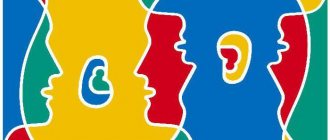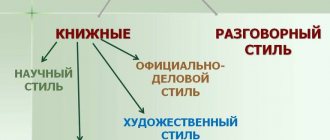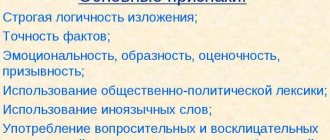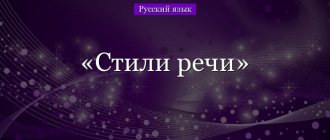In the modern Russian literary language, there are 5 functional styles of speech: colloquial, journalistic, official business, artistic and scientific style of speech.
In this article we will analyze in detail the scientific style of speech. You will find answers to the following questions:
- what is scientific style of speech;
- its main function and tasks;
- scope of application;
- features and characteristics of the scientific style;
- substyles or varieties;
- genres of scientific style of speech;
- example of a scientific text.
What is the scientific style of speech, its functions and tasks
The scientific style of speech is a functional style of speech of the Russian literary language, which is a means of communication in the field of scientific, scientific-professional and educational-scientific activities.
The main function of the scientific style of speech is informative. It consists in conveying objective information about man, nature, and society.
The task of the scientific style is to explain natural and social phenomena, identify patterns and identify cause-and-effect relationships.
Scientific style texts are distinguished by clarity, logic, accuracy, objectivity and evidence-based presentation of information.
Historical excursion
In Ancient Greece, the privileged class used special terminology that ordinary people did not understand. It was to this time that experts attribute the appearance of the first signs of the scientific style. All terms were called only in Latin, but over time, scientists began to translate details into other languages.
Narrow-profile areas of activity began to expand. Initially, the scientific style of speech differed little from the artistic one, but over time, characteristic features began to appear and the style became clear and concise.
As an example, we can recall Descartes’ negative review of Galileo’s works. The French philosopher and mathematician believed that the Italian physicist tended to use a large number of artistic devices in the text. Kepler also held a similar opinion. For a long time, the standard of style was the work of Isaac Newton. Everyone tried to imitate him in their works.
In the Russian state, a style for scientific work began to take shape only at the beginning of the 18th century. Mikhail Lomonosov especially helped in its development, who developed certain characteristics of the style.
The formation process was finally completed in the 19th century and was associated with the activities of major scientists. Today, the style of scientific works has a number of features that make it easy to distinguish it from other styles of the Russian language:
- Logicality - all parts of the text have a strict sequence and end with a conclusion. Sentences are linked by repeating nouns and demonstrative pronouns. Adverbs, conjunctions, and introductory words also indicate consistent presentation.
- Precision - all words are used only in the literal sense. Terminology is widely used. Key phrases may be repeated many times.
- Objectivity - describes the results of experiments and the patterns that were identified.
- Generalization - when writing a text, the author uses abstract concepts that are almost impossible to imagine, feel, or understand.
If necessary, the text is illustrated with graphs, diagrams, diagrams. You can apply formulas, calculations, and make tables. The author’s task is to fully disclose the topic.
Scope of application of scientific style
The scope of application of the scientific style of speech is the field of science and educational and scientific activity.
First of all, it is used in written form of speech: textbooks, articles, dissertations, reports, encyclopedias, etc. But it is also found in oral form (for example, during scientific conferences).
To design presentations, printed materials, and publications, I recommend using Canva. This is a very simple and convenient all-in-one visual editor. With thousands of professional templates, images, and other quality elements, you'll get a great starting point to bring your best ideas to life.
Language characteristics
The scientific style finds its expression and consistency in certain units of speech. Its linguistic characteristics can be of 3 types:
- Lexical units. Determine the functional and stylistic coloring of the text. They have special morphological forms and syntactic structures.
- Stylistic units. Responsible for the neutral functional load of the text. Thus, their quantitative predominance in the report becomes the determining factor. Individually marked units occur as morphological forms. Less commonly, they may acquire syntactic structures.
- Interstyle units. They are also called neutral language elements. Used in all styles of speech. They occupy the largest part of the text.
Main features and characteristics of the scientific style of speech
The features and characteristics of the scientific style include:
- Logical presentation - information is presented consistently and in a clear sequence.
- Generality, accuracy and objectivity in the presentation of information.
- Evidentiary and rich presentation (many arguments, facts).
- Application of terms and general scientific words. On average, terms occupy about 15-20% of the total text volume.
- The use of words with an abstract meaning (these are words that do not evoke specific images in the mind and memory, for example: property, essence, worldview, reality).
- Most often there is a monologue character of speech.
- More nouns and adjectives, and a minimum of verbs.
- Complex sentence construction.
- The sentences are mostly long.
- Practically no means of expression are used (epithets, comparisons, metaphors, etc.) and there is no expressive-emotional vocabulary (admirable, son, inspire, despise, sycophant).
- Correct word order.
- Strict sequence of presentation.
Official business (stationery) style
Texts of this style exist within the framework of document flow.
Their task is to put any life story into a ready-made clerical scheme. This is necessary to resolve legal and financial issues that consider aspects of legal relations in various life situations.
For example, if you want to transfer to another school, your parents write an application addressed to the director. If you missed a class, you will have to write an explanatory note. And if you are dissatisfied with the service at the service center, you may want to leave a complaint.
What types of business texts are there? Resume, questionnaire, application, petition, official appeal, explanatory, denunciation - all these are genres of official business style.
Each of them has a pattern that should not be deviated from. If in your explanatory note you start to paint a picture of the dog that ate your homework, the teacher, of course, will laugh, but such text will not work as an exculpatory document.
Here are the main features of formal business style texts:
- uniformity;
- consistency;
- subsequence;
- the presence of clerical phrases (clericalisms);
- dryness, emotionlessness;
- lack of means of artistic expression.
Clerical style texts are the exact opposite of literary texts. Moreover, bureaucracy corrodes the soul of an artistic (and journalistic) text. Remember this when writing essays and remembering what text styles exist in the Russian language.
Scientific style of speech: its varieties or substyles
Like other styles of speech, the scientific style is rarely found in its “pure” form. Scientific texts may contain elements of both journalistic and official business style of speech.
Because of this interaction with other styles of speech, and depending on the purpose and specific application, the scientific style is divided into 6 substyles :
- Proper scientific or academic: dissertations, reports, communications, monographs, speeches;
- Educational and scientific: textbooks, lecture courses, course work, seminar report;
- Popular science: popular science books and magazines, children's encyclopedias;
- Scientific and informative: abstracts, reviews, summaries, theses;
- Scientific reference: encyclopedias, dictionaries, reference books;
- Scientific and technical: patents, standards, descriptions of inventions, specifications, technical conditions.
| Substyle name | Target | Genres |
| Actually scientific | Definition and description of new phenomena, facts, patterns. | dissertations, reports, communications, monographs, speeches, scientific articles. |
| Educational and scientific | Transferring scientific information to students, teaching, describing the facts necessary for mastering and mastering the material. | textbooks, lecture courses, course work, seminar report, notes, oral response. |
| Popular science | Familiarization with facts and phenomena. | popular science books and magazines, children's encyclopedias, articles. |
| Scientific and informative | Transmission of scientific information with a description of scientific facts. | abstracts, reviews, theses. |
| Scientific reference | Providing the reader with the ability to quickly find the necessary scientific information. | encyclopedias, dictionaries, reference books. |
| Scientific and technical | Application of scientific achievements in practice. | patents, standards, descriptions of inventions, specifications, technical conditions. |
Substyles (varieties) of scientific style of speech and examples of genres
Linguistic characteristics
Each style can have its main characteristic features - lexical, morphological, syntactic. The linguistic features of the scientific style include the use of certain vocabulary.
Its distinctive features:
- words are used only in the literal sense;
- artistic means of expression are not used - metaphors, hyperboles, epithets, etc.;
- abstract sentences and terminology are used.
Three groups of words can be used in the text - those with stylistic neutrality, general scientific and highly specialized. The use of terms depends on the substyle and audience. For example, in popular science books it is undesirable to use a large number of special words and a simplified presentation of information is allowed.
Features of morphology:
- a small number of first and second person singular verbs;
- a large number of present tense verbs and verbal nouns;
- adjectives are rarely used.
Syntactic features make it possible to distinguish the scientific style from others. This group may include such features as the use of special phrases, for example, according to experience or according to Newton. “Next” is often used as an introductory word. To logically link sentences use:
- "corresponding";
- "famous";
- “given”, etc.
A large number of complex sentences of complex type are used. With their help, generalizations are made or certain phenomena are described. Conjunctions are used to logically connect sentences.
The text necessarily uses references to the works of other scientists, especially if the author wants to show different points of view on one problem. Sentences include participles and gerunds.
Genres of scientific style of speech
Genres of scientific style are types of scientific texts that differ in their structure and functions.
There are several classifications of genres of scientific style. For example: primary and secondary scientific works or genres with free (articles, reviews) and with a fixed writing structure (dissertation).
In this article we will consider the classification of genres depending on the specific communicative and information functions that they perform.
Scientific style of speech: genres of the scientific substyle
The main function of this substyle is to identify and describe original research results, to present new facts, phenomena and patterns.
Genres of the scientific sub-style include:
- A monograph is a scientific study devoted to one specific phenomenon, fact, issue or topic. The volume of the classic text of the monograph is more than 120 pages in A4 format. This is a full-fledged scientific work.
- A scientific article is a short essay in which the author describes the results of his own research.
- A dissertation is a qualifying work, the successful completion of which is necessary for the award of an academic degree. Volume: from 50 to 500 pages. Available in the form of a book or bound manuscript.
Genres of this substyle also include reports, messages, and speeches.
Texts of the proper scientific substyle have a general writing structure, which includes:
- Name.
- Introduction.
- Main part.
- Conclusion.
Genres of educational and scientific substyle
Educational and scientific speech is used in the learning process, namely for the transmission and development of scientific information by students.
There are oral and written genres of educational and scientific substyle. Oral ones include: message and response .
The main written genres of this substyle are:
- A report is a detailed message on a specific issue, based on documentary data. The purpose of the report is to inform and provide recommendations or suggestions.
- A textbook is a teaching tool designed to assimilate, deepen and expand knowledge.
- Note - a summary or brief recording of a lesson, lecture, article.
- A course of lectures is a collection of lecture texts by one or more authors on individual topics or on the course as a whole. Covers the content of the academic discipline.
Popular science genres
This substyle is intended to disseminate scientific information among the mass recipient (for example, among a certain category of readers - children, teenagers, etc.).
Popular science genres include:
- Popular science books are literary works about science, scientists, scientific achievements and research, intended for a wide range of readers.
- Popular science magazines.
- Children's encyclopedias.
- Articles.
Genres of the scientific and information substyle
The function of the scientific information substyle is to convey scientific information.
The main genres of this substyle:
- An abstract is a short report on a specific topic, which collects information, most often from several sources.
- A review abstract is a report that compares different points of view on a particular issue. Compiled based on several sources.
- An abstract is a short report that outlines only the main points.
- The thesis is the leading genre of scientific style. It is a short record that outlines the main points of scientific research.
Genres of scientific reference substyle
The task of the scientific reference sub-style is to provide the reader with the ability to quickly find the necessary scientific information.
The main genres of the scientific reference substyle are:
- Encyclopedia is a scientific reference review of all or individual branches of knowledge in the form of a dictionary.
- A dictionary is a collection of words with their translation, interpretation and explanation.
- A reference book is a book that contains brief information of a scientific, social, industrial or applied nature.
- Catalog is a list of information about objects, the purpose of which is to facilitate the search for these objects by a certain criterion.
Scientific style of speech: genres of the scientific and technical substyle
The scientific and technical substyle is common in technical documentation. The texts of this substyle serve to apply in practice all the achievements that have been obtained as a result of theoretical and experimental scientific research.
The genres of the scientific and technical substyle include:
- A patent is a document certifying the exclusive right to an invention, product or process.
- Specification is a definition and list of specific features, a refined classification of something.
- Technical specifications are a document establishing the technical requirements that a specific product, material, substance, etc., or a group of them must meet.
- Standards.
- Description of inventions.
Journalistic text style
Among other text styles, journalistic can be called the most mobile, active, and rapidly changing.
It is designed to convey to people the most relevant information, to share useful information in the shortest possible time, to call for action - that is, one way or another, to influence not only the minds of readers and listeners, but also their emotions.
Within the journalistic text, the following text styles are distinguished:
- newspaper and magazine substyle (articles, essays, interviews, notes);
- language of television and radio (reviews, interviews, conversations);
- oratory (appeals, congratulatory and funeral speeches);
- The language of advertising is considered as an intermediate element>.
The vocabulary of the journalistic style is a synthesis of scientific and colloquial speech.
Since a publicist interacts with society, he has to actively use the terms of politics, sociology, and cultural studies. At the same time, the speeches of such a speaker must be accessible to absolutely all segments of the population, so proverbs, sayings, jokes, and aphorisms are used.
The language of journalism is emotional, aimed specifically at each listener or reader. It is designed to evoke a lively reaction, a vivid and instant response.
Structure of scientific text
Any scientific text, regardless of genre, is built according to a single logical scheme.
The basis is always a thesis - a statement that requires justification. To confirm and substantiate this thesis, the text must present argumentation and provide evidence . Often, for a more complete argument, illustrations - examples that confirm the scientific assumptions put forward.
The text ends with a conclusion or summary , which outlines an assessment of the research conducted and also presents prospects for further study.
Varieties of scientific language
According to modern standards, there are several types of scientific style in the Russian language, which have their own characteristics. These include the following speech styles:
Popular science
This type of text is addressed to those people who do not have special skills and knowledge in any specific area. It is characterized by simplicity of presentation in order to achieve accessibility for the public, but at the same time it retains a sufficient amount of terminology and clarity.
In addition, it is allowed to use such speech forms that evoke emotion in the audience. The purpose of scientific public language is to familiarize people with certain facts or phenomena.
This species also has a subspecies called scientific and artistic. With this presentation, a minimum of special terminology and numerical values are used, and if they exist, then experts try to explain them in detail.
The popular science style is characterized by comparative analysis with ordinary objects, easy reading and perception of information. This text is used in books, magazines and other publications.
Training
It is designed for people studying in educational institutions. The purpose of this style is to introduce pupils and students to the information that is required to acquire certain knowledge in a particular area.
The scientific style and its features in this case consist in the use of many typical examples. This style is characterized by the use of professional terms, a clear division into categories, and smooth transitions from the general to the specific. Such texts can be found in textbooks, manuals, and manuals.
Actually scientific
In this case, the audience is people specializing in the field and scientists. The task of such texts is to describe certain facts, phenomena, patterns, and so on. You can draw your own conclusions in them, but do not color them with special emotionality. An example of this type of scientific style can be found in dissertations, reports, and reviews.
Technical
This type is necessary for highly specialized specialists. The purpose of this style is to describe skills and abilities that were acquired through practical means. It is characterized by a lot of digital, statistical data and technical characteristics.
An example of texts written in a scientific style of speech
“A tornado is a strong small-scale vortex that arises in a thunderstorm (cumulonimbus) cloud and spreads in the form of a dark “trunk” towards the water or earth’s surface.
In the upper part, below the lower boundary of the cloud, the vortex has a funnel-shaped expansion. The barrel of a tornado descends to the earth's surface, its lower part, in contact with it, takes the form of an overturned funnel. The height of a tornado can reach 800–1500 m. The air in it rotates most often counterclockwise, rising in a spiral upward, drawing in dust or water, and fragments of objects destroyed on the ground.
The air rotation speed can reach 50–100 m/s with a strong upward component and cause catastrophes. destruction, sometimes accompanied by loss of life. At the same time, near his path there may be complete calm. Inside the tornado, the air pressure decreases, condensation of water vapor occurs there, which, together with the elongated part of the cloud, dust, water and decomposition. the debris makes death visible. Its axis is vertical, but often has a curved appearance.”
Electronic encyclopedia
» Existing territorial planning schemes for environmental management do not contribute to the creation of environmentally-oriented economic activities, which leads to conflict situations between economic entities both within the Kaliningrad region and outside it. Analysis of the features of socio-economic development and environmental policy made it possible to identify a number of significant methodological and methodological shortcomings in territorial planning and development. In particular, the development of the Kaliningrad region is carried out on the basis of poorly coordinated and poorly environmentally oriented departmental plans: urban planning, agricultural, reclamation, water, forest management, recreational and others.
Environmentally-oriented landscape planning can help in solving problems of territorial development. The landscape program of the Kaliningrad region is a strategic planning document for the use of the territory, forming an information and reference field for a wide range of organizations and officials responsible for the development and adoption of management territorial planning decisions, as well as state and non-state environmental and environmental funds, international organizations in the field of environmental control and management.
One of the most important tasks in implementing the program is the development of an integrated map of environmentally-oriented use of the territory and a map of environmental management conflicts. Solving these problems without the use of geographic information technologies is very complicated and sometimes impossible.”
Excerpt from the scientific article “Introduction of open geoinformation technologies into environmental planning methods”
Information sources:
- Russian language for technical universities. Scientific style. Author: Yu. Smirnova
- Wikipedia
- Russian language and culture of speech. Authors: Tatyana Balykhina, Mikhail Rybakov, Marina Lysyakova.
- Stylistics of scientific speech and editing of educational and methodological materials. A textbook for teachers and educators of the secondary education system.
- Photo on the cover of the article - science.sciencemag.org
PS: Did you like the article? Share the link on social networks, thank you!
Artistic style of text
The pinnacle of literary language is literary text. It includes literary works of different types and genres: novels, stories, stories, ballads, poems, poems and much more.
In order to talk about an object, person or phenomenon so that it gets into the very heart of the reader, the writer uses artistic images . To create them, there are many means of artistic expression: metaphors, comparisons, epithets, personifications, hyperboles, litotes, synecdoche, metonymies.
Each word in a literary text lives a special life. It is irreplaceable and significant. If you rearrange the lines in Pushkin's poem or skip the description of nature in Turgenev's novel, part of the author's intention will escape the reader and the charm of the text will dissipate.
Writers work on their works for many days, months, years, choosing the only right words, intonations, and images. That is why our favorite stories and poems touch us so deeply and remain with us for life.
The styles of a literary text depend on the individual author’s style of each writer, therefore in literary criticism and linguistics it is customary to talk about the language and style of Pushkin, Bunin, Nabokov, etc.
And finally - two useful tips
Read more scientific literature . By reading scientific literature, you not only study your subject, but also acquire scientific style. Any writer (even if this writer is a scientist) is first and foremost a reader.
We also recommend: How to search for information for a scientific article
Try to write scientific texts . Reports, essays, coursework - for teachers this is a way to test your knowledge, and for you, writing such works is an excellent opportunity to master the scientific style in practice. And if you already have a supervisor, ask him to check your articles not only from the point of view of compliance with the scientific specifics, but also from the point of view of style.
Text tone
Errors in the tone of the text are probably more common in texts on humanities subjects. In any case, not only popular science, journalistic, critical, but even scientific publications in these disciplines very often contain value judgments expressed very biasedly. In addition, professional historians (or philologists) may profess and defend different political views. Of course, ideally, no political or, more broadly, ideological attitudes should influence scientific research. Scientificity should not be sacrificed for worldview. However, this is not always the case.
And young historians and philologists, reading the “passionate” books of their older colleagues, extract from them not only facts, but also the way they are presented - most often polemical (in this case, of course, we are not talking about the whole science, but only about the most characteristic samples of this kind, which at the same time turn out to be the most readable).
However, a scientific article should still be relatively neutral and operate with verifiable data that is not based on the author’s adherence to some narrow worldview. Of course, being scientific does not exclude polemics - however, this polemic must be conducted adequately, ethically and not go beyond the bounds of scientificity.









